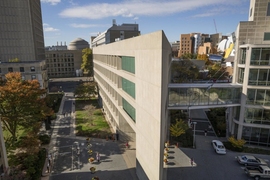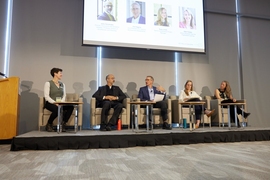How is MIT working to meet its goal of decarbonizing the campus by 2050? How are local journalists communicating climate impacts and solutions to diverse audiences? What can each of us do to bring our unique skills and insight to tackle the challenges of climate and sustainability?
These are all questions asked — and answered — at Sustainability Connect, the yearly forum hosted by the MIT Office of Sustainability that offers an inside look at this transformative and comprehensive work that is the foundation for MIT’s climate and sustainability leadership on campus. The event invites individuals in every role at MIT to learn more about the sustainability and climate work happening on campus and to share their ideas, highlight important work, and find new ways to plug into ongoing efforts. “This event is a reminder of the remarkable, diverse, and committed group of colleagues we are all part of at MIT,” said Director of Sustainability Julie Newman as the event kicked off alongside Interfaith Chaplain and Spiritual Advisor to the Indigenous Community Nina Lytton, who offered a moment of connection to attendees. At the event, that diverse and committed group was made up of more than 130 community members representing more than 70 departments, labs, and centers.
This year, Sustainability Connect was timed with announcement of the new Climate Project at MIT, with Vice Provost Richard Lester joining the event to expound on MIT’s deep commitment to tackling the climate challenge over the next 10 years through a series of climate missions — many of which build upon the ongoing research taking place across campus already. In introducing the Climate Project at MIT, Lester echoed the theme of connection and collaboration. “This plan is about helping bridge the gap between what we would accomplish as a collection of energetic, talented, ambitious individuals, and what we're capable of if we act together,” he said.
Highlighting one of the many collaborative efforts to address MIT’s contributions to climate change was the Decarbonizing the Campus panel, which provided a real-time look at MIT’s work to eliminate carbon emissions from campus by 2050. Newman and Vice President for Campus Services and Stewardship Joe Higgins, along with Senior Campus Planner Vasso Mathes, Senior Sustainability Project Manager Steve Lanou, and PhD student Chenhan Shao, shared the many ways MIT is working to decarbonize its campus now and respond to evolving technologies and policies in the future. “A third of MIT's faculty and researchers … are working to identify ways in which MIT can amplify its contributions to addressing the world's climate crisis. But part and parcel to that goal is we're putting significant effort into decarbonizing MIT'S own carbon footprint here on our campus,” Higgins said before highlighting how MIT continues to work on projects focused on building efficiency, renewable energy on campus and off, and support of a cleaner grid, among many decarbonization strategies.
Newman shared the way in which climate education and research play an important role through the Decarbonization Working Group research streams, and courses like class 4.s42 (Carbon Reduction Pathways for the MIT Campus) offered by Professor Christoph Reinhart. Lanou and Shao also showcased how MIT is optimizing its response to Cambridge’s Building Energy Use Disclosure Ordinance, which is aimed at tracking and reducing emissions from large commercial properties in the city with a goal of net-zero buildings by 2035. “We’ve been able [create] pathways that would be practical, innovative, have a high degree of accountability, and that could work well within the structures and the limitations that we have,” Lanou said before debuting a dashboard he and Shao developed during Independent Activities Period to track and forecast work to meet the Cambridge goal.
MIT’s robust commitment to decarbonize its campus goes beyond energy systems, as highlighted by the work of many staff members who led roundtables as part of Sustainability in Motion, where attendees were invited to sit down with colleagues from across campus responsible for implementing the numerous climate and sustainability commitments. Teams reported out on progress to date on a range of efforts including sustainable food systems, safe and sustainable labs, and procurement. “Tackling the unprecedented challenges of a changing planet in and around MIT takes the support of individuals and teams from all corners of the Institute,” said Assistant Director of Sustainability Brian Goldberg in leading the session. “Whether folks have sustainability or climate in their job title, or they’ve contributed countless volunteer hours to the cause, our community members are leading many meaningful efforts to transform MIT.”
The day culminated with a panel on climate in the media, taking the excitement from the room and putting it in context — how do you translate this work, these solutions, and these challenges for a diverse audience with an ever-changing appetite for these kinds of stories? Laur Hesse Fisher, program director for the Environmental Solutions Initiate (ESI); Barbara Moran, climate and environment reporter at WBUR radio; and independent climate journalist Annie Ropeik joined the panel moderated by Knight Science Journalism Program at MIT Director Deborah Blum. Blum spoke of the current mistrust of not only the media but of news stories of climate impacts and even solutions. “To those of us telling the story of climate change, how do we reach resistant audiences? How do we gain their trust?” she asked.
Fisher, who hosts the TIL Climate podcast and leads the ESI Journalism Fellowship, explained how she shifts her approach depending on her audience. “[With TIL Climate], a lot of what we do is, we try to understand what kinds of questions people have,” she said. “We have people submit questions to us, and then we answer them in language that they can understand.”
For Moran, reaching audiences relies on finding the right topic to bridge to deeper issues. On a recent story about solar arrays and their impact on forests and the landscape around them, Moran saw bees and pollinators as the way in. “I can talk about bees and flowers. And that will hook people enough to get in. And then through that, we can address this issue of forest versus commercial solar and this tension, and what can be done to address that, and what's working and what's not,” she said.
The panel highlighted that even as climate solutions and challenges become clearer, communicating them can remain a challenge. “Sustainability Connect is invaluable when it comes to sharing our work and bringing more people in, but over the years, it’s become clear how many people are still outside of these conversations,” said Newman. “Capping the day off with this conversation on climate in the media served as a jumping-off point for all of us to think how we can better communicate our efforts and tackle the challenges that keep us from bringing everyone to the table to help us find and share solutions for addressing climate change. It’s just the beginning of this conversation.”














